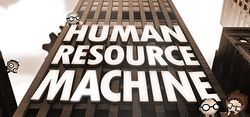(Add sequel link) |
m (Move to new genre) |
||
| (2 intermediate revisions by 2 users not shown) | |||
| Line 1: | Line 1: | ||
{{Header Nav|game=Human Resource Machine | {{Header Nav|game=Human Resource Machine}} | ||
{{Game | {{Game | ||
|completion=2 | |||
|image=Human Resource Machine logo.jpg | |||
|title=Human Resource Machine | |title=Human Resource Machine | ||
|developer=[[Tomorrow Corporation]] | |developer=[[Tomorrow Corporation]] | ||
|publisher= | |publisher={{colist|Tomorrow Corporation|Experimental Gameplay Group}} | ||
| | |year=2015 | ||
|genre=[[ | |systems={{syslist|win|macos|wiiu|linux|ios|droid|switch}} | ||
| | |genre=[[Programming]] | ||
|modes=[[Single player]] | |||
|followed by=[[7 Billion Humans]] | |||
|pcgamingwiki=Human Resource Machine | |pcgamingwiki=Human Resource Machine | ||
}} | }} | ||
'''Human Resource Machine''' is a visual programming-based [[puzzle]] game developed by [[Tomorrow Corporation]]. The game was released for [[Microsoft Windows]], [[OS X]] and [[Wii U]] in October 2015, being additionally released for [[Linux]] on March 29, 2016, for [[iOS]] on June 1, 2016, and for [[Android]] on December 1, 2016. Human Resource Machine uses the concept of a corporate office worker assigned to perform tasks that involve moving objects between an inbox, an outbox, and to and from storage areas as a metaphor for assembly language concepts. The player works through several puzzles in constructing a program to complete a specific task. | '''Human Resource Machine''' is a visual programming-based [[puzzle]] game developed by [[Tomorrow Corporation]]. The game was released for [[Microsoft Windows]], [[OS X]] and [[Wii U]] in October 2015, being additionally released for [[Linux]] on March 29, 2016, for [[iOS]] on June 1, 2016, and for [[Android]] on December 1, 2016. Human Resource Machine uses the concept of a corporate office worker assigned to perform tasks that involve moving objects between an inbox, an outbox, and to and from storage areas as a metaphor for assembly language concepts. The player works through several puzzles in constructing a program to complete a specific task. | ||
==Gameplay== | |||
The game includes approximately 40 programming puzzles, each considered one "year" of the player's avatar tenure in a corporate structure. In each puzzle, the player creates a list of instructions from rudimentary commands to control the movements of their avatar on an overhead view of an office; the office includes two conveyor belts, one an inbox that sends in either an integer or a single alphabetic character represented as a small box, the other an outbox to receive these. The office floor typically also includes a number of marked number spaces that can hold one box each. For each puzzle, the player is told of a specific task, such as adding two numbers as they come in on the inbox, or sorting a zero-terminated string of characters, delivering these results in the proper order to the outbox. | The game includes approximately 40 programming puzzles, each considered one "year" of the player's avatar tenure in a corporate structure. In each puzzle, the player creates a list of instructions from rudimentary commands to control the movements of their avatar on an overhead view of an office; the office includes two conveyor belts, one an inbox that sends in either an integer or a single alphabetic character represented as a small box, the other an outbox to receive these. The office floor typically also includes a number of marked number spaces that can hold one box each. For each puzzle, the player is told of a specific task, such as adding two numbers as they come in on the inbox, or sorting a zero-terminated string of characters, delivering these results in the proper order to the outbox. | ||
{{ToC}} | {{ToC}} | ||
[[Category: | [[Category:Tomorrow Corporation]] | ||
[[Category:Programming]] | |||
[[Category:Single player]] | [[Category:Single player]] | ||
Latest revision as of 10:06, 10 November 2022

| Human Resource Machine | |
|---|---|
| Developer(s) | Tomorrow Corporation |
| Publisher(s) | Tomorrow Corporation, Experimental Gameplay Group |
| Year released | 2015 |
| System(s) | Windows, macOS, Wii U, Linux, iOS, Android, Nintendo Switch |
| Followed by | 7 Billion Humans |
| Genre(s) | Programming |
|---|---|
| Modes | Single player |
Human Resource Machine is a visual programming-based puzzle game developed by Tomorrow Corporation. The game was released for Microsoft Windows, OS X and Wii U in October 2015, being additionally released for Linux on March 29, 2016, for iOS on June 1, 2016, and for Android on December 1, 2016. Human Resource Machine uses the concept of a corporate office worker assigned to perform tasks that involve moving objects between an inbox, an outbox, and to and from storage areas as a metaphor for assembly language concepts. The player works through several puzzles in constructing a program to complete a specific task.
Gameplay[edit]
The game includes approximately 40 programming puzzles, each considered one "year" of the player's avatar tenure in a corporate structure. In each puzzle, the player creates a list of instructions from rudimentary commands to control the movements of their avatar on an overhead view of an office; the office includes two conveyor belts, one an inbox that sends in either an integer or a single alphabetic character represented as a small box, the other an outbox to receive these. The office floor typically also includes a number of marked number spaces that can hold one box each. For each puzzle, the player is told of a specific task, such as adding two numbers as they come in on the inbox, or sorting a zero-terminated string of characters, delivering these results in the proper order to the outbox.